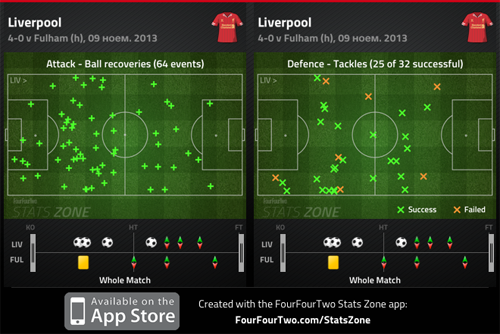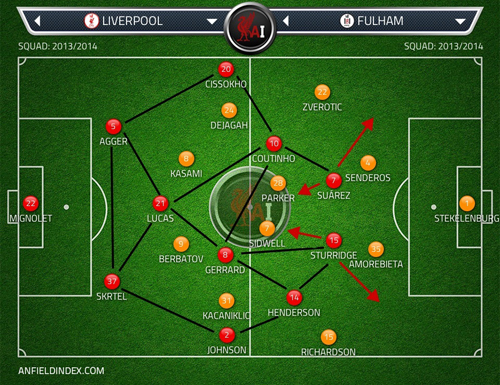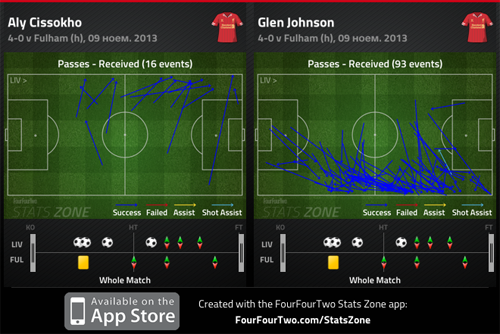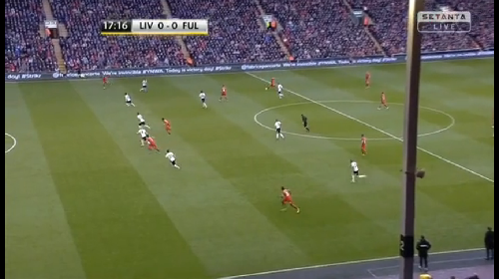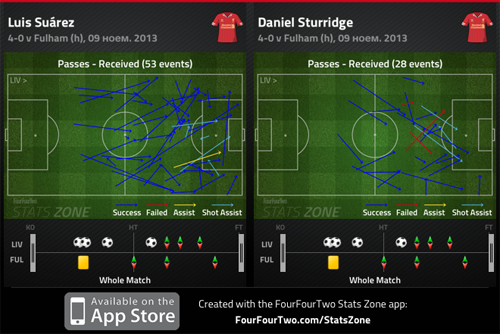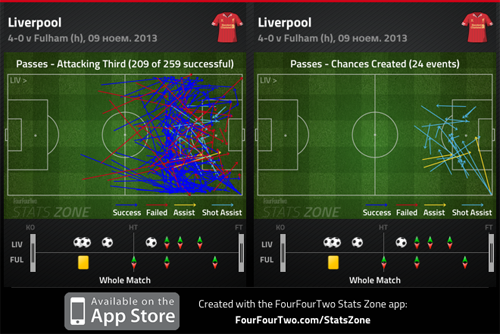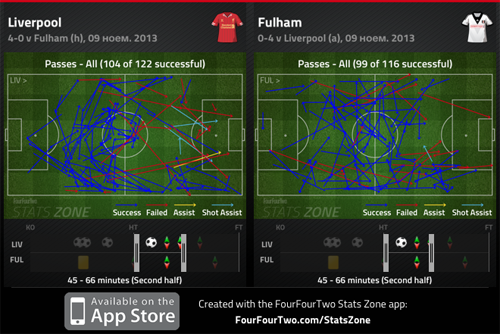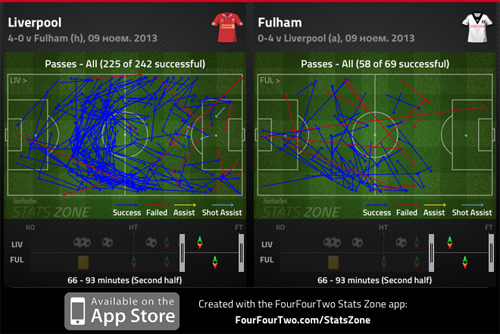By Mihail Vladimirov.
Rodgers made the expected switch and returned to a back four system. Sakho and Toure were replaced by Agger and Coutinho to accommodate the change. Enrique was only fit to start on the bench, therefore Cissokho continued at left-back.
Fulham lined up more or less as expected. With Riether (suspended) replaced by Zverotic and Hangeland (still injured) missing the game, Jol named the same back four. It was announced Ruiz had some back pain in the days before the game, so he started on the bench with Kasami partnering Berbatov in attack. As expected Kacanicklic started on the left flank, but with Ruiz on the bench Jol continued with Dejagah on the right.
Fulham
The game itself was totally one-sided, with Fulham being a disgrace for a top-flight team in terms of their general application and their total lack of resilience and clear strategy when it came to defending throughout.
It was clear the visitors attempted, and more often than not succeeded, in dropping deep into two banks of four, leaving Kasami and Berbatov higher up. However, the way the wide players participated in it totally defeated the purpose of having this defensive system. Both Kacaniklic and Dejagah quickly dropped back in their half, staying goal side and looking like solidifying the midfield zone whenever Liverpool tried to build their way through the zones. But at the same time both showed a total lack of effort to either engage their direct opponents (Liverpool’s full-backs) or stay in touch with their full-backs and midfielders. Generally speaking, Fulham’s wingers both remained static and once beaten – either positionally or for the ball – they stood still, watching events unfold around them.
With Liverpool playing a high line, it was a case of Cissokho and Johnson starting their advance from around the central line, meaning that, relatively early, they got past Fulham’s wide men. From there it was a case of Liverpool easily creating overloads both down the flanks and through the middle (more on this later).
The matter was made worse by defensively uninterested Kasami and Berbatov were. They neither tried to close down Liverpool’s centre-backs, putting them under pressure in order to slow the home team’s passing flow, nor did they drop deep in order to occupy Lucas and Gerrard and prevent easy passes towards them. Berbatov was his usual lazy self – either just standing or half-heartedly strolling around at a very low pace. Then, although Kasami tried a few times to drop towards his midfield partners, he was as easily beaten and bypassed as Fulham’s wingers.
With four of the players clearly not participating in any way defensively, Fulham generally defended with six players. Although Parker and Sidwell showed surprising positional discipline and remained largely ahead of the centre-backs, they were simply overrun, left with no support either centrally or from out wide. As a whole they tried to compete as much as they could, often being the only players trying to either engage Liverpool’s players or being in the right position to prevent a Liverpool attack becoming even more dangerous. But forced to put fires out all over the place, it was unsurprising to see them struggle to contain Liverpool’s attacks on their own.
Then by the time the centre-backs were called into action, it was a case of facing several Liverpool players, coming from several angles and at full speed both on and off the ball. Amorebieta and Senderos were running hopelessly around the penalty area, completely overloaded and without knowing what to do first or where exactly to go. Often it was a case of seeing them resort to desperate last-ditch effort just to try and minimise the damage from yet another overwhelming wave of Liverpool attacks.
Right from the start, Fulham’s body language and the players’ faces perfectly illustrated the defeatist mood the team was playing with. There was no sign of a team motivated to perform as a unit, trying to stick together and defend enthusiastically. There was no trace of a clear game plan of how the team was supposed to try and nullify the opposition. The team seemed keen to drop into two banks of four and stand-off the opposition in order to focus on defending the zones. But the players remained largely unorganised and lacked the positional solidity associated and required by that strategy. The lack of communication or encouraging words between the players followed the mute behaviour from their manager on the bench. It was a spiritless performance, lacking even the bare minimum of fight from a team who knows what’s coming and just waited for the initial expectations to turn into reality.
Obviously, all of this provided Liverpool with the perfect platform to exploit their qualities and enjoy their football. It was precisely how Liverpool dominated and won so convincingly that delivered the only tactically fascinating aspects in this game. To say Fulham played poorly and Liverpool were great would be an understatement about the level the home team performed in this game tactically and technically.
Not fierce closing down, but considered pressing
The way Liverpool performed when attacking and in possession was outright sublime. Nevertheless, one thing that needs to be outlined too was the team’s strategy and the way the players executed it when out of possession.
In short, there are three ways of behaving when out of possession. The first one – the most reactive approach – is to stand-off the opposition, with the emphasis on quickly retreating into your defensive shape. The focus here is on giving them time on the ball but in order to limit the space they would have to be in your half and near the penalty area.
The other two approaches are considered the proactive ones, given they aim to put pressure on the opposition and try to limit the time they would have on the ball. However, one of them has mainly defensive aspirations. By closing down the opposition the team would minimise the space between the players, forcing the opposition into quicker passing. This is designed to lead to eventual mistakes (misplaced passes, poor first touch etc), with the aim of at least not letting the opposition get on with their passing flow, if not fully ruin it. This approach doesn’t focus so much on stealing the ball and either counter-attacking dangerously or regaining possession in order to retain the ball. Its main design is to prevent the opposition having time on the ball to settle with their passing flow and spreading out in attack. Therefore this approach could be termed as the proactively reactive one.
The alternative approach is more to do with the team’s aim to quickly and fiercely press the opposition with the single focus of winning the ball back as soon as possible. From there the team is expected to decide whether the situation offers a counter-attacking possibility and going for it. Or if not, the team would proceed with calmly recycling possession until an opportunity for a killer pass or sudden break presents itself. The main aim behind this approach is connected with attacking aspirations (either counter-attacking swiftly or retaining the ball) and not defensive (preventing the opposition enjoying their passing flow). Following this, this is the most straight and direct proactive approach for a team when out of possession.
With this in mind one could easily guess the level of effort and aggressiveness associated with each approach. The standing-off approach is the lowest on that front – there is no real effort or need to engage the opponents unless they are in your ‘hot zone’. When closing down, the players are expected to time their runs and pick out moments when and where to try and minimise the space between them and the opponents. The pressing approach requires a fierce and non-stop effort, as soon as the ball is lost, with the key aim to give the opposition as little time as possible on the ball.
However, what is interesting is that in the past few games there is a trend to see Liverpool displaying a mixture of these three approaches. Last season the team showed each of them separately in different games. But this season, and especially in the last two home games, Rodgers’ team blurred the boundaries between them and combined them into one. It’s obvious that the team is neither pressing fiercely all over the pitch (as Dortmund or Southampton are doing in each game), nor being overly reactive by simply standing-off. Nor do they only fiercely close down, before quickly backing-off when the ball is re-positioned by the opponent. What Liverpool display is what I’ve started to term: ‘considered pressing’.
This means the team is inclined to press the opposition with the aim of regaining the ball and, either proceeding by breaking forward or by going on to recycle possession. But, this is not done all the time, with the whole team constantly pressing all over the pitch as soon as the ball ends up with the opposition. Instead, the team is showing remarkable situational intelligence and judgement to pick out specific moments when the probability of sudden, fierce pressing which leads to a ball recovery is obviously higher. Generally the team is in a state of permanently standing-off (in order to keep up the designed defensive shape) mixed with readiness to go on and quickly close down the nearest opposition in order to delay their attacks. But all of this is topped with that constant assessment of the situations, based on which players are ready to suddenly break loose and show a fierce press in its truest form. Against both WBA and now Fulham the team showed this very specific strategy, leading to the players constantly switching between the three behaviours, depending on how the players evaluated and deemed each situation. This meant there were several times when the team fiercely pressed the opposition, with the result often ending with a dangerous counter-attack being constructed.
In a way it could be said that – in contrast to, for example, Dortmund and Southampton – Liverpool are focused on the ball and, depending on the situation, are switching between standing-off (to minimise the space for the opposition to do something with it), closing down (not letting the opposition have the ball for extended periods of time and settling into a decent passing flow) and pressing (picking out moments where the aim is to regain the ball quickly to do something proactive with it). The difference is that outright pressing teams like the two mentioned before are mainly focused on pressing the opposition as a means of both a defensive and offensive strategy. They constantly press fiercely by sticking tight to their opponents in order to prevent them receiving the ball and as a result having a higher chance for either intercepting the ball or tackling the player in possession. Liverpool seem to be more focused on pressing the ball by waiting for situations when the players deem it’s highly probable a sudden effort of intense pressure will lead to dispossessing the opposition and breaking forward.
Keep this in mind and consider for a minute that Rodgers was complementary of how his team pressed in both these games. What’s more, he often refers to his team being good when pressing the ball. This at least suggests, if not fully reveals, that this type of constantly switching behaviour is what Rodgers wants from his team. This makes sense in that all of the above variants, on their own, have downsides. The standing-off leaves too much time on the ball for the opposition. The closing down variant, as much as it could be useful, is neither progressive enough to win the ball back nor reactive enough to focus on being positionally solid all the time. The downright fierce pressing leaves the team vulnerable, in that the team is often out of shape, leaving too much space for the opposition to break into, and is physically demanding – something that can’t be sustained throughout every single game.
The mixture of all three provides the benefits of each variant, combined into a cohesive strategy, based on triggers which the players are expected to switch and use each variant, based on the situation. This is highly demanding in terms of cohesion and players’ intelligence, but on paper it seems to be the most complete and all-round approach. Not least because it gives the opposition enough time on the ball to lure them higher up the pitch before either closing them down (to limit their passing flow) or pressing them fiercely to go on to exploit the space in behind on the break.
What seems to be a growing trend for Rodgers’ Liverpool is the team being focused on closing down rather cautiously from high up, but instead they press aggressively (when the situation is deemed ‘on’ by the players) in the midfield third. This is especially notable against teams like WBA and Fulham, who were expected to focus on dropping deep and staying firmly in defence. With this approach Liverpool gave them time on the ball in deep areas to try and lure them forward. But in order to not let them just pass in the deep areas, Liverpool tried to close them down enough to force them to pass the ball forward. From then it was a case of picking the right moments to press them, regain the ball and exploit the space in behind on the break.
Against both WBA and Fulham, Liverpool created several dangerous counter-attacks using this strategy. The best example of that happening in this game was at the start of the second half, and for the fourth goal, where Gerrard and Henderson go and press Richardson 2-v-1, Gerrard regains the ball and sends Suarez through on goal to score. But there were at least half a dozen other examples, all around the midfield zone, where Liverpool chose moments to suddenly switch to a sudden fierce press, and created potent attacking moves in the process.
Structure, versatility and flexibility
In terms of formation, Liverpool’s shape could be described in several ways; and all of them would be true, given the positional flexibility displayed by the players. On one hand, with Coutinho clearly playing much narrower than Henderson, it could be described as a lopsided 4-2-3-1. But then Henderson often drifted infield too, either to join the build-up play or dart diagonally off the ball – hence the label 4-2-2-2 wouldn’t be wrong either. Finally, with Lucas clearly staying as the deepest midfielder all the time and the five ahead of him more or less all having positional freedom, the framework could have been rightly pointed out as being a 4-1-3-2.
However, no matter the exact numerical label, this Liverpool XI were full of positional flexibility and versatility in terms of the type of players on the pitch. Generally the team had two centre-backs, two wing-backs, four midfielders and two forwards. But it was each player’s different input, on and off the ball, which resulted in the highly diverse but perfect, complementary and balanced framework throughout each phase and zone of play.
Play out from defence
The first obvious benefit of the asymmetrical formation, full of flexible lines, was the ability to have triangles all over the pitch. This meant the team’s desired build-up process from behind would always be intact, and the ball movement would always be safe. Lucas dropping towards the centre-backs signalled the wing-backs to push forward, which in turn enabled Coutinho and Gerrard to move, constantly opening up the required angles through the middle. The former often dropped, but stayed as the most advanced, narrow and to the left, with Gerrard lurking in between and to the right. As a result this pushed Suarez and Sturridge forward, free to roam all over the place and drop in wherever there was a pocket of space that could help the team’s transitioning.
With Fulham generally lining up in rigid and straight 4-4-2 lookalike shape – and putting next to no pressure on the player in possession – Liverpool’s fluid formation found it too easy to safely pass the ball out of defence.
Midfield diversity
The key for many systems and styles of play is the midfield zone. Defensively, that unit is expected to support the defence and prevent it being easily overrun by the opposition. Offensively, this is the zone from where team would be expected to create and sustain the majority of its possession, to then turn that into penetrative attacking moves. As such, the midfield unit is expected to boost both passers but also additional attacking runners.
With Fulham not posing Liverpool enough danger, this game was one of the easiest the home team had from a defensive point of view. Therefore, the main interest is in how the midfield unit performed in possession and when attacking.
The crucial aspect of Liverpool’s display in this game proved to be the midfield diversity between the four players featuring in that zone. Not only did they all operate in mainly different zones but, overall, they had a different input on and off the ball, which helped provide the required effect of balance based on diversity.
Lucas being the deepest meant he was expected to spearhead the team’s recycling process and link the defence with the midfield. As touched on above, he constantly dropped towards the centre-backs to collect the ball. This encouraged the other players to spread out properly, which in turn enabled the required efficient transitional play. The Brazilian was at his best on the ball, linking the team with short and accurate passes from deep. But he was also impressive when needed to break down the rare occasion when Fulham tried to construct attacking moves.
With the Brazilian doing his job, it meant Gerrard and Coutinho could focus on their own roles. With Lucas dropping deep and ensuring the proper passing out of defence, Gerrard had a licence to roam and open up additional angles through the middle. But then, with Fulham rarely in possession and almost never posing any direct attacking threat, Liverpool’s captain could focus on linking-up the midfield and the attack in two different ways: first, providing different types of passes to Lucas – as it was obvious that Gerrard’s emphasis was to deliver those switching-the-play, quicker and searching balls towards the flanks. Additionally he seemed tactically free, determined to burst forward and connect with the rest of the attacking players by constantly entering the final third. The majority of the team’s best attacking moves saw him have a key input by either passing the ball and switching the play or simply being one of the main off the ball runners. The pass towards Henderson preceding the third goal, or the angled through ball towards Sturridge in the 62nd minute, are just some (of several) good examples of his influence on his Liverpool’s attacks.
In addition, Coutinho’s on and off the ball movement was another vital cog in Liverpool’s midfield. First, by constantly moving into narrow positions between the lines, effectively occupying the zone from where he could act as a typical #10, he provided a different type of player than Lucas, Gerrard and Henderson. If Lucas was focused on simple, short passes and with Gerrard focused on switching the play, Coutinho provided that neat passing finesse, in terms of those final, defence-splitting passes from the edge of the penalty area. Unfortunately, as was the case last week against Arsenal, almost all of them were either poorly timed or simply over-hit. The only such pass that succeeded, and was technically up to scratch, was the angled one which sent Sturridge into a good shooting position at the start of the second half. In addition, Coutinho regularly wasted a decent attack by being too greedy and going for the shot himself, when passing it seemed the more useful choice.
However, if the Brazilian’s final balls were often poor, his general movement played a vital role. By constantly moving infield and dropping deep he enabled Liverpool to enjoy that 3-v-2 midfield advantage over Parker and Sidwell. From there, he entered into several passing sequences, exchanging passes with his teammates in order to move the ball around. There were several situations where thanks to his good ball control and quick movement, Liverpool created some simply marvellous slick passing moves in Fulham’s half.
However, the tip of the iceberg (ED: Love this phrase, had to leave it in, couldn’t think of an alternative) came from Henderson’s dual role; by staying predominantly wider, and helping Johnson constantly create an overload down the right flank, Liverpool enjoyed two areas of numerical advantage: 3-v-2 in midfield and 2-v-1 down the right flank. This resulted in the team having three clear areas of strength: through the middle, down the right flank and up front with Suarez free to play as a second forward.
Given his display, it’s safe to say Henderson performed two roles. The first one was staying wider, as a right-sided player. From there he not only joined Johnson to cause constant havoc in that part of Fulham’s defence, enabling Johnson to mix his attacking style by both going on the outside and also cutting infield, Henderson was also a threat himself, by making several dangerous and technically well executed crosses. A great example was his low cross that found both Coutinho and Gerrard completely free on the edge of the penalty area in the 20th minute, only for the Brazilian to scuff his shot off target. His other role was to pick his moments and either drift infield to join the build-up play and free one of Coutinho or, more often than not, Gerrard to burst forward. Or alternatively, he himself darted inside to threaten the opposition with his well-timed diagonal runs off the ball.
When combined into a whole, these four players delivered a full range of tactical and technical capabilities from within the midfield zone, something that greatly helped Liverpool look so fluent in possession, and so fluid when interchanging in terms of movement. In any given moment one of Coutinho, Gerrard and Henderson could be seen playing the passing role, the other providing the decoy run and the third being the main additional direct attacking player, heading in and around Fulham’s penalty box.
Flying wing-backs
With Liverpool having Henderson and Johnson rampaging down the right, and Henderson playing much wider than Coutinho, it was only logical to see the team using the right flank much more than the left. This meant Johnson was used drastically more than Cissokho. The game ended with Henderson and Johnson having exchanged 60 passes between them down that flank, an outstanding figure. Johnson was his usual devastating self – constantly overlapping to join the team’s attacks. If he and Downing often looked like striking a great tactical understanding (in that both players could either stay wide or move infield) this game showed that the Johnson-Henderson pair has the potential to reach the same highs, and arguably be better, thanks to Henderson’s capable efficiency in providing that additional threat by moving diagonally off the ball.
Although Cissokho was drastically less involved, he did his tactical job quite well. He constantly bombed forward to occupy Zverotic’s attention and allow Coutinho to drift freely infield to try and influence the attacking moves. The fact the team played with a high defensive line greatly helped both Cissokho and Johnson to be so brave in attack, constantly seeking to push forward. Instead of having to run from within their half, more often than not they started their runs from just behind the central lines and had to run only 15-20 metres before posing a direct attacking threat to Fulham.
One situation in particular caught the attention in relation to how ambitious both wing-backs were, even if Johnson ended up being the more influential. In the 17th minute, the team showed their structure of building-up from behind with the team pushing higher up the pitch. The centre-backs went wider with Lucas in between them, then Gerrard to the right of him with Henderson and Coutinho occupying advanced and narrow positions. It was a case of Gerrard picking up the ball and sending a delightful long pass in behind Fulham’s defence for Suarez and Sturridge (who both were pushing ahead) to run onto. However, in that situation, both Johnson and Cissokho were level with the forwards, having acres of space in front of them by already sneaking past Fulham’s full-backs.
Proper front pair
With such a stable platform behind them, Suarez and Sturridge had the full freedom to concentrate exclusively on how best they could hurt the opposition. With Coutinho moving infield and making up the midfield numbers, Suarez was completely free to play as a full-time second forward. He and Sturridge rarely combined directly. From the six times they did, however, there were two goal-scoring chances created. The first one being at the start of the second half – in the 47th minute, where Sturridge sent Suarez in behind Fulham’s defence, but the Uruguyan shot rather weakly. Ten minutes later, it was the other way around with Suarez trying to do the same with Sturridge, only for the latter to be flagged offside. However, their best work as a front duo came from the constant danger they posed when relating to and providing the reverse movement for each other. Whenever one of them dropped deep, the other looked to push on. One of them drifting wide saw the other remaining central to keep the centre-backs occupied. Not only that, but they seemed perfectly in line with what the others tried to do and helped them by either showing for the ball or acting as the decoy. For example, the situation in the 14th minute where both forwards moved in a way to completely confuse Fulham’s backline, thus securing that diagonal channel for the in-cutting Henderson to rush into, trying to latch onto Coutinho’s through ball. Although the situation in itself didn’t lead to a goal-scoring chance created due to Henderson being blocked, this was just one example of Liverpool’s positional play, the players’ cooperation and on-ball techniques in full flow.
The whole whirlpool of constant movement fluidity and passing fluency led to Liverpool having no less than 21 situations (including the goals) where one could easily label it as either being a clear goal-scoring, or at the very least, half-clear chance. This just shows how much Liverpool dominated Fulham.
Second half subs and different type of domination
At half-time Jol opted to introduce Ruiz for Kacaniklic, putting him behind Berbatov with Kasami now on the left. Although Fulham looked the same team in terms of formation and personnel, this change seemed to bring a much more positive attitude with the visitors now looking to push forward.
Although this served to level the game in terms of passes made by both teams, this only led to Liverpool having more space to break into. Before the fourth goal, Liverpool had four very good chances for a goal, all of which, more or less, ought to have resulted in another goal. After Suarez’s second goal, Fulham obviously collapsed, with Liverpool’s attacking appetite logically and drastically minimised. Liverpool continued to dominate but they did so at a much lower pace.
Around the hour mark Rodgers too opted to bring some players on. First it was Enrique given the chance to get back up to fitness, replacing Cissokho in 61st minute. But the sub in the 66th minute proved to be key to how the last half an hour of the game would be played and how Liverpool would dominate in a different manner. Allen replaced Gerrard which, whether intentionally or not, completely changed the outlook of the team from a tactical point of view.
Obviously Allen is a different type of player to Gerrard. The former is more of a recycler, focused on helping the ball retention process by passing and moving in a way to be always free to help the ball just tick over. The latter is more of a penetrating-oriented passer, looking to quickly switch the ball direction and the tempo of the play by offering those quicker and penetrative balls all over the place. In addition, although Gerrard admirably adapted his role since Rodgers came in and started to drop towards the centre-backs and help with the initial phase of play, he is still very much an attacking player, always looking to bomb forward whenever he can to join the team’s attacks. In contrast, Allen is a much tidier and more responsible player, who will first look around before deciding whether it’s suitable for him to push forward or not.
As such, it was logical to see Liverpool’s midfield quickly gaining a different outlook. Whereas Allen spent more time dropping towards Lucas than trying to link up with the front players, and Gerrard also looked to offer penetration and range with his passes, Allen’s were much more shorter and ‘safe’ looking. Add to this that in the 75th minute Moses replaced Sturridge to play on the left with Coutinho now through the middle and Liverpool now had midfielders all able to simply recycle the ball and offer that ‘death by football’ effect. It was a case of, in the last half an hour, Liverpool completely stifling Fulham with the ball. The majority of the passes were in deep and non-threatening areas but they helped to kill off the tempo.
One could say that what Liverpool displayed before and after the Gerrard-Allen sub were two totally distinct playing styles. Although both counted on dominating the possession, they used the ball in a different way and for different aims. Before the sub, Liverpool showed total football built around the famous pass and move mantra, in order to be as penetrative on and off the ball as possible. What followed next was a different dimension of total football. The penetrative approach was replaced with a much more conservative type of the same pass and move style. If the former aimed to overload and overrun the opposition all over the pitch, with several points of attacks in any given moment, the former aimed to simply suffocate them with a much gentler but similarly effective way.
Summary
It’s hard to look at this Fulham side and see reasons why Jol should be retained as their manager based on their current form and their participation, or lack of, in this game.
On the other side, Liverpool were simply unstoppable. The opposition was obviously below par but what the home team displayed was nothing short of sublime from a tactical and technical point of view. The way the team was structured and behaved in attack is arguably Liverpool at their deadliest; and is exploiting the maximum tactical and technical potential presented by the current squad. For this, the manager and the players should be praised as highly as possible.
***** A reminder from Mihail – there is still time to send questions for the next version of ‘A Question of Tactics’ this week, to asktactics@mail.com. The deadline is this Friday. *****

